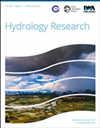利用多变量方法进行二元区域干旱频率分析:伊朗西南部案例研究
IF 2.4
4区 环境科学与生态学
Q2 Environmental Science
引用次数: 0
摘要
区域频率分析 (RFA) 中的双变量方法解决了两个问题:第一,评估区域的同质性;第二,估算联合回归期。本研究旨在调查伊朗西南部历史上严重干旱的联合回归期。首先使用模糊 c-means 聚类(FCM)算法将 59 个雨量计聚类为 3、4 和 5 个区域。然后应用双变量不一致性和同质性检验来调整初始聚类。结果显示,只有在三个聚类的情况下,所有区域都是同质的。因此,可以推断将聚类分析和不一致性检验结合起来不足以形成同质区域。最后,通过选择广义 Logistic 分布和 Wakeby 分布作为边际分布,Clayton 分布作为协整 分布,对三个区域的所有地点进行了联合回归期估计。由于没有一个三参数分布函数能很好地拟合变量严重程度,因此二元同质性指数并不一定能证明区域在边际分布函数方面的同质性。此外,还推断出年平均降水量(MAP)较高、海拔也相应较高的地点更有可能经历较短的相同干旱事件回归期,而年平均降水量较低或海拔较低的地点则相反。本文章由计算机程序翻译,如有差异,请以英文原文为准。
Bivariate regional drought frequency analysis using multivariate approaches: a case study in southwestern Iran
Bivariate approaches in Regional Frequency Analysis (RFA) address two issues: first, to evaluate the homogeneity of regions, and second, to estimate the joint return periods. This study was conducted to investigate the joint return period of a severe historical drought in southwestern Iran. Fifty-nine rain gauges were first clustered into three, four, and five regions using the fuzzy c-means clustering (FCM) algorithm. Then bivariate discordancy and homogeneity tests were applied to adjust the initial clusters. The results showed that only in the case of three clusters all the regions were homogeneous. Therefore, it can be inferred that combining clustering analysis and discordancy test is insufficient to form homogeneous regions. Finally, the joint return period, by choosing Generalized Logistic and Wakeby as marginal distributions and Clayton as a copula, was estimated for all the sites in the three regions. Since no three-parameter distribution function fitted well to the variable severity, the bivariate homogeneity index does not necessarily attest to region homogeneity regarding the marginal distribution functions. it is also deduced that sites with higher mean annual precipiataion (MAP) and, correspondingly, higher elevation are more likely to experience shorter return periods of same drought events, in contrast to sites with lower MAP or lower elevation.
求助全文
通过发布文献求助,成功后即可免费获取论文全文。
去求助
来源期刊

Hydrology Research
Environmental Science-Water Science and Technology
CiteScore
5.30
自引率
7.40%
发文量
70
审稿时长
17 weeks
期刊介绍:
Hydrology Research provides international coverage on all aspects of hydrology in its widest sense, and welcomes the submission of papers from across the subject. While emphasis is placed on studies of the hydrological cycle, the Journal also covers the physics and chemistry of water. Hydrology Research is intended to be a link between basic hydrological research and the practical application of scientific results within the broad field of water management.
 求助内容:
求助内容: 应助结果提醒方式:
应助结果提醒方式:


